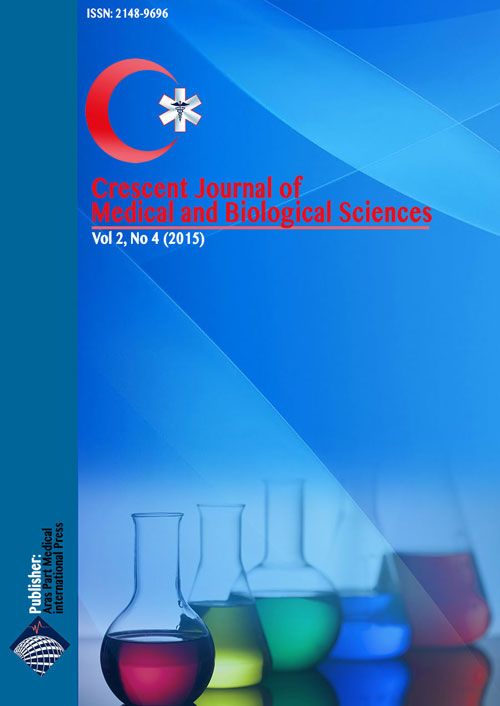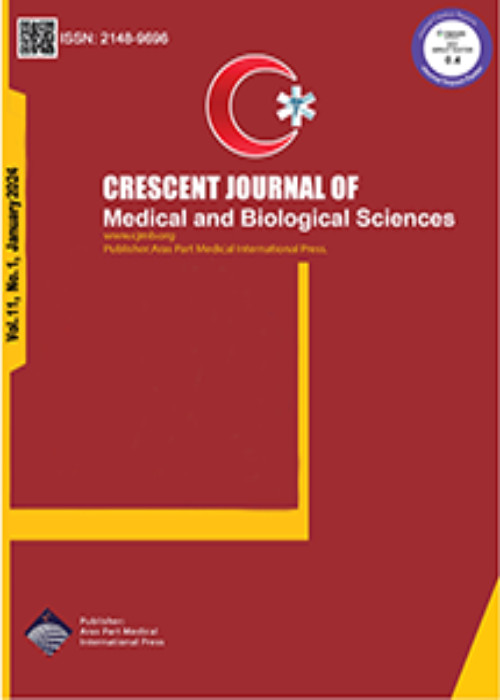فهرست مطالب

Crescent Journal of Medical and Biological Sciences
Volume:2 Issue: 4, Oct 2015
- تاریخ انتشار: 1394/09/21
- تعداد عناوین: 8
-
-
Pages 106-110ObjectiveUrinary catheterization is one of most common practices in medical centers and hospitals. Despite the advantages of catheterization, it might cause serious complications such as trauma, urinary tract infection and urinary incontinence. Therefore, improper insertion of the catheter is not only useless, but may also cause morbidity and mortality, cost of diagnosis and treatment and waste of time.Materials And MethodsIn the retrospective study conducted during 2013 to 2014, all hospitalized patients in Infectious Disease ward of Sina hospital in Tabriz were examined and information in respective checklists was recorded. Finally data were analyzed by SPSS 16 software.ResultsAmong the 723 patients, 94 (13%) who had undergone catheterization. Twenty-five patients who were catheterized before referring to emergency were excluded. Finally, 69 patients (9.5%) were studied. The mean age was 21.85 ± 65.39. Forty-seven patients (68.1%) were catheterized. Twenty-two patients (31.9%) were improperly catheterized. Causes of improper catheterization were: to make nursing easier and patient care with 9 people (40.9%), medical failure with 8 people (36.4%) and taking urine samples with 5 people (22.7%). Thirty percent of patients had complications such as hematuria, urinary incontinence and urinary tract infection. None of the study variables were significantly associated with improper catheterization (P <. 05).ConclusionDespite the usefulness of insertion of urinary catheter, it is associated with adverse events. Improper catheter increases the risk of complications. About 1/3 of patients in Infectious Disease ward of Sina hospital in Tabriz were improperly catheterized and 30% faced complications.Keywords: Complications, Urinary catheters, Urinary tract infection
-
Pages 111-115ObjectiveOne control method of pathogenic microorganisms is using synthetic chemical preservatives and antibiotics. Because of being generally recognized as safe, antibacterial compounds with organic origin are considered important for health. This study was done in order to investigate the antibacterial effects of methanol extracts of the Berberis vulgaris (Barberry), Actinidia deliciosa (Kiwi) and Allium cepa L. (Onions) on the standard strain (ATCC:19114) of Listeria monocytogenes (L. monocytogenes), as it seems that it is possible to find some important organic and health safe anti-Listerial compounds.Materials And MethodsAfter collecting the mentioned plants phytology study was done. Then methanol extracts of named plants were prepared and antibacterial effects of these plants against the mentioned strain of L. monocytogenes by the Disk Diffusion, minimum inhibitory concentration (MIC) and minimal bactericidal concentration (MBC) methods were performed. Also Ampicillin (10 μg/disc) was used as the reference antibacterial substance. In order to find the relationship between antibacterial properties of plants extracts independent t test, chi-square and analysis of variance (ANOVA) tests were used.ResultsResults showed that the extracts of all the three studied plants had antibacterial effects on L. monocytogenes. Average diagonal of growing area in disk diffusion test for barberry, kiwi and onions in order was 12, 15.5 and 11 mm. Also MIC of mentioned plants extracts in order was 125, 62.5, and 125 μg/ml and MBC of named plants was 500, 250 and 500 μg/ ml, respectively.ConclusionThe results of this work showed that methanol extracts of kiwi had stronger anti-Listerial effect than barberry’s and onion’s extracts.Keywords: Actinidia, Anti, bacterial agents, Listeria monocytogenes, Onions
-
Pages 116-120ObjectiveTreatment with aminoglycosides is a preventable cause of acute kidney injury (AKI). Early predictive markers of AKI are crucial in preventing this condition. This study aimed to examine the role of serum neutrophil gelatinase-associated lipocalin (NGAL) level as a predictive marker of AKI in patients receiving gentamicin.Materials And MethodsIn this prospective study, 37 patients with brucellosis (23 males, 14 females; mean age = 10.7 ± 33.7 years) were studied in a health center between March 2013 and March 2014. Serum creatinine and NGAL levels at baseline, and 3, 5 and 7 days after the administration of gentamicin were measured. In this study, a 25% increase in the serum creatinine levels compared with the baseline levels was considered a criterion for AKI risk.ResultsThe frequencies of patients prone to AKI at the first, third, fifth and seventh day of administration of gentamicin were 0%, 8.1%, 18.9%, and 13.5%, respectively. In total, 24.3% of the patients (n = 9) were prone to AKI. No statistically significant difference was observed between NGAL levels before and after the administration of gentamicin (P =. 082).ConclusionThe serum NGAL level is not a sensitive and specific predictor of AKI following the administration of gentamicin. Therefore it is recommended to increase the frequency of sNGAL measurement and using more sensitive kits in more patients.Keywords: Serum neutrophil gelatinase, associated lipocalin, Acute kidney injury, Brucellosis, Gentamycin
-
Pages 121-124ObjectiveMany of Ziziphora species have been used in traditional medicine in North of Iran. This work was determined on ecological requirements, antioxidant and antibacterial activity of Ziziphora clinopodioides Lam. from Bovanloo region, Iran.Materials And MethodsAerial parts of plant in blooming were collected from Deraznoo mountain (2500 m) in August 2013, ecological and traditional data were recorded. The aqueous and methanol extracts were isolated by maceration, antioxidant capacity were measured by total antioxidant capacity (TAC), reducing power (RP) and 2,2-diphenyl-1-picrylhydrazyl (DPPH) in comparison with butylated hydroxy toluene (BHT) and butylated hydroxyanisole BHA antioxidant standard and then their antibacterial activity were studied in vitro against 9 gram positive and negative bacteria by using well method and the minimum inhibitory concentration (MIC) assay.ResultsZiziphora clinopodioides Lam. (Z. clinopodioides Lam) often grows in sunny environment in Deraznoo mountain (2500 m), with annual rainfall of 334 mm and annual temperature of 10.3°C in temperate cold climate and sandy loam soil with Ec = 0.6 and pH = 6.9. It has been used by the rural people as an antispasm, anti-inflammatory, antifungal, anti-infective, sedative and expectorant agent to treat cold, flu, diarrhea, gasterointestinal disorder and stomach ache. The ethanol extract of plant had high antioxidant activity with IC50 values (32.5 ± 0.4 μg/ml) especially in DPPH assay and exhibited good antibacterial activity on Staphylococcus aureus, Staphylococcus epidermidis, Bacillus cereus and Pseudomonas aeruginosa with IZ (28.1 ± 0.5, 24.8 ± 0.1, 19.4 ± 1.1 and 14.8 ± 1 mm), respectively with high MIC value of 14.5 μg/ml, respectively.ConclusionThe methanol extract of Z. clinopodioides Lam. have suitable antibacterial and antioxidant activity which can be used as natural anti-infective agent to treat many infectious diseases.Keywords: Antioxidants, Anti, infective agents, Ecological
-
Pages 125-129ObjectiveThe aim of this study is to assess the antioxidant properties of onion on biochemical serum factors, antioxidants and testicular tissues in Wistar rats after consuming tartrazine.Materials And MethodsForty male Wistar were divided into four groups of 10. The first group was used as the control group and were given only water without additives, group 2 were given tartrazine, group 3 were given tartrazine plus onion juice and the fourth group which was given only onion juice through gastric gavage. The experiment was conducted for 60 days, then the antioxidant activities superoxide dismutase (SOD), catalase (CAT), glutathione peroxidase (GPx) and biochemical parameters namely high density lipoprotein (HDL), low density lipoprotein (LDL) and testosterone together with the histopathological studies (sperm count and testicular weight) were measured.ResultsTartrazine caused a decrease in the activity of antioxidant enzymes (SOD, CAT, GPX) and a decrease in the level of testosterone and HDL and also a decrease in sperm count and testicular tissue weight. Tartrazine caused an increase in the LDL levels.ConclusionResults showed that consumption of tartrazine is associated with production of free radicals and in turn causes significant decrease in antioxidant activities and biochemical serum factors which damage the cellular compartments of the testis. Onion as an antioxidant in this study reduces the damaging effects of tartrazine on the enzymatic activities of antioxidant and biochemical serum factors.Keywords: Antioxidants, Onions, Tartrazine, Testicular tissue, Water
-
Pages 130-134ObjectiveLipid oxidation and generation of free radicals are important factors contributing to the formation of atherosclerotic plaque. Bilirubin is supposed to play a protective role against atherosclerosis, coronary artery diseases (CAD) and inflammation for its strong antioxidant property. Thus, this study aims at investigating the relationship of bilirubin level with the severity and type of coronary artery stenosis (CAS) in different patient groups.Materials And MethodsIn this cross-sectional study 200 consecutive patients, who underwent elective angiography in Madani Heart hospital, Tabriz, Iran, were selected and their blood samples were measured for total, direct, and indirect bilirubin level, with Diazo method using colorimetric technique. Following angiography, comparisons were made between the severity and location of CAS and therapeutic follow-up plan with total, direct, and indirect bilirubin level.ResultsOf 200 studied patients, 129 (64.5%) and 71 (35.5%) subjects were male and female, respectively. The cases were classified into 5 subgroups based on angiography results as follows: 59 (29.5%) cases with normal angiography, 11 cases (5.5%) with minimal CAD, 56 cases (28%) with single vessel involvement, 35 (17.5%) cases with two vessel involvement and 39 cases (19.5%) with three vessel involvement. The mean total bilirubin level was 1.47 ± 0.8 mg/dl, 1.27 ± 0.12 mg/dl, 1.27 ± 0.06 mg/dl, 1.6 ± 0.04 mg/dl and 0.98 ± 0.05 mg/dl, respectively for the cases with above order. The mean difference in serum total bilirubin between normal angiography group and three-vessel involvement group was 0.49 mg/dl (P <. 0001). There was a significant inverse relation between bilirubin level (total, direct and indirect) and number of involved vessels and involvement intensity increased as serum bilirubin level decreased. Severity of coronary arteries stenosis as well as the number of involved vessels increased as serum bilirubin level decreased.ConclusionAccording to results, there was a significant inverse relation between serum bilirubin level and coronary involvement (type and intensity). Higher bilirubin serum levels played a protective role against CAD, even in the presence of other risk factors. Therefore, bilirubin level can be used as a predictor of CAD in the future.Keywords: Angiography, Atherosclerosis, Bilirubin, Coronary vessels


